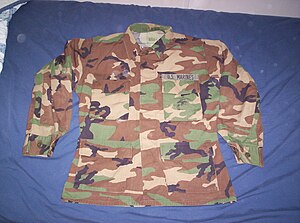Three color desert camouflage
| Battle Dress Uniform | |
|---|---|

A U.S. Marine Corps BDU blouse in the "M81" woodland pattern, with the wearer's nametape removed. The ironed-on "EGA" on the breast pocket is barely visible, having worn off due to wear.
|
|
| Type | Battledress |
| Place of origin | United States of America |
| Service history | |
| In service | 1981–2008 (U.S. Army) 1981–2005 (U.S. Marine Corps) 1981–2011 (U.S. Air Force) 1981–2012 (U.S. Navy) |
| Wars |
Cold War Kosovo War Global War on Terrorism |
| Production history | |
| Designed | 1980 |
| Manufacturer | Propper |
| Unit cost | 50$ (MSRP in February 2001) |
| Produced | 1981–2012 |
| Variants | Desert Camouflage Uniform, Desert Battle Dress Uniform |
The Battle Dress Uniform (BDU) are camouflaged fatigues that were used by the United States Armed Forces as their standard uniform for combat situations from the early 1980s to the mid-2000s. Since then, it has been replaced or supplanted in every branch of the U.S. Armed Forces, except for certain elements of the U.S. Coast Guard as of 2013. As late as 2014, BDUs were still worn by officers of the U.S. Public Health Service as the prescribed uniform for deployment, but have since been replaced by a variant of the U.S. Coast Guard's ODU.
BDU-style uniforms and derivatives still see widespread use in other countries (some of them being former U.S. surplus stocks transferred under U.S. security assistance programs), while others are still worn by some U.S. federal, state and local law enforcement agencies or activities who may work in tactical situations, such as the DEA FAST and SWAT teams.
The BDU uniform is referred to as battle dress uniforms because they are intended for use during "battles", as opposed to "garrison" or "service" dress uniforms which are worn at parades and formal functions.
While the Italian Army was the first military organization to issue camouflaged clothing, albeit in limited numbers, the Germans were noted for their efforts in this field before the Second World War. After much trial, the Oberkommando der Wehrmacht (abbrev. OKW) authorized Heeres-Splittermuster 31, more commonly known as "splinter pattern", for use in shelter-quarters (Zeltbahnen) in the 1930s. In 1940, SS-Verfügungstruppe (abbrev. SS-VT; renamed Waffen-SS) designed, tested and issued its own distinctive patterns and layout not long after.
...
Wikipedia
